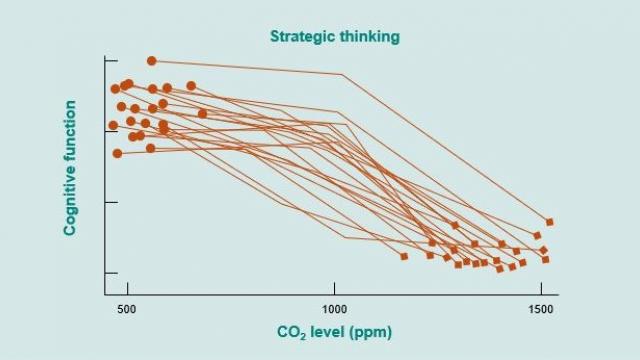Main
Getting your priorities right
Interestingly, we exert great effort and expenditure to equip workplaces and educational buildings with the latest technologies to facilitate learning and productivity, but we usually neglect the indoor environment. Temperatures outside the comfort zone, for example, negatively impact performance, and science has unequivocally shown there is a link between indoor air quality and our capacity for strategic thinking and learning. Studies clearly indicate investing in the indoor environment pays huge dividends.
One study1 shows that 33% of respondents report ventilation affects their performance at work or school ‘quite a lot’ or ‘a great deal.’ The same study also indicates that 57% consider their home ventilation superior to that of their workplace, which is a strong incentive to invest in an effective indoor climate solution in workplaces and schools, where we spend most of our time.
Learning institutions are very important to our society and their buildings’ indoor environments are critical to the learning experiences and health of our children. Particularly, younger children can be at high risk because they are physically more active and their lungs less developed, so they breathe more intensely.

Poor indoor air can cause headaches, dizziness, nausea, irritation of the eyes, nose and throat, and skin problems, such as dermatitis. It can also cause behavioral problems in children, adversely affect brain development, learning ability, cognitive function and academic performance, while slowing healing and recuperation processes.
According to scientific studies2, cognitive function declines significantly at levels of carbon dioxide concentration (CO2) common indoors (about 950 ppm). Increasing ventilation, on the other hand, lowers CO2, VOC and other pollutant concentrations, raising cognitive function. The figure below depicts the relation between better air quality due to higher rates of ventilation and the improvement in strategic thinking.

Making sound decisions: the product of breathing good air
Another study involving chess players supports findings that providing clean air improves cognitive ability. 5 Increased concentrations of 10µg/m3 of PM2.5 saw error probability rise by up to 9.7%. And when playing in tense situations, the error rate nearly doubled to 17.4%. Knowing this, do you want you or your people making important decisions while breathing contaminated air?
Furthermore, recent findings indicate that poor indoor air quality impacts mental health, increases risk of depression, bipolar disorder, schizophrenia, and personality disorder, etc.
It is important to remember that the science of indoor air quality is extremely complex, with many contributing factors, including:
Air pollutants and their sources are diverse (outdoors and indoors)
Building age, type and construction
Decorative furnishings
Temperature and humidity
Ventilation system (natural, hybrid, mechanical, other)
Occupant activity and behavior
These articles might interest you as well:

light
Lighting has the power to make you more effective
You know the feeling of a sunny day? When everything is merrier and brighter and you are filled with energy?

filtration
Air quality affects your productivity
There are many studies that show that poor air quality can affect your performance levels, not just physical performance, but also your cognitive and decision-making abilities, as well.

ventilation
Ventilation and the health of your building
In our push to cut carbon emissions, the pressure to increase the energy-efficiency of our buildings is intensifying.
Sources:
1 Study conducted by Swegon 2019 in Sweden
2Associations of cognitive function scores with carbon dioxide, ventilation and volatile organic compound exposures in office workers: A controlled exposure study of green and conventional office environments. Allen Joseph et al. 2015
